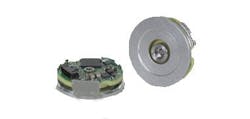Resolvers are great for high-shock and high-vibration applications because there are no electronics involved. But for the most part, encoders today are able to do everything that a resolver can do.
We provide turnkey automation systems primarily in packaging, material handling, and printing and converting, involving hydraulic, pneumatic and electrical motion technologies. In our applications, we use optical and inductive encoders to control position, velocity and commutation.
Inductive encoders, because they lack optics, benefit from good shock and vibration resistance. They also enable larger designs such as hollow-shaft applications—about 4 in. in diameter, which is twice the size possible with optical encoders.
But optical encoders provide greatly improved resolution, which has become a more important criterion for many printing applications. Essentially, the higher the resolution the better, but resolutions in the million-counts-per-revolution range work well for our applications.
Fortunately, those kinds of resolutions are easier to come by these days, and at an appreciably lower price than even just a few years ago. There is no longer a cost tradeoff for resolution, which has become virtually free for the asking. You just have to ask for it. And if you combine the optical encoder with an intelligent drive, you easily could have an excess of 16 million counts per revolution.
Partly because high resolutions are so attainable, expectations for printing resolutions are much higher today than they once were. Even a four-color press requires considerable control from one print head to another, but most printing tools today are eight- or 10-color presses, requiring even more precise resolution control. Even on a cereal box, you want the print to be sharp. Imagine a picture of an athlete in which the colors are off registration. Besides the picture, any perforations on that package need to be lined up precisely as well.
While the print resolution on a paper cup, for example, might not need to be so fine, the resolution on a candy wrapper will be fussier. A Snickers bar wrapper needs to be "dead nuts," as we call it. But as time goes on, more and more items will require higher resolution.
As consumers, we not only demand HDTV these days, but HD images in our newspapers and packages, too. Manufacturers want a great-looking product with lots of high-resolution colors that will stand out on the shelf, and getting an even subtle improve could require a 10x boost in resolution.
We're responsible for giving them a machine control that can provide the resolutions they expect. If you want high-resolution printing, converting or packaging, you want high-resolution encoders.
Encoder resolution will continue to rise. This also allows a system to run at a higher bandwidth, enabling more responsiveness, with an effect of increased system throughput and repeatability.
Some other improvements we see for the future include larger bore sizes with integral bearing sets. We're already using hollow-shaft encoders, which enable mounting right onto a machine. They're available as large as 50 mm in diameter, and Heidenhain's encoders, for example, have their own internal bearings. This design gives us a tremendous amount of flexibility, and virtually eliminates the need for other parts such as couplings or bearings.
Multi-turn absolute encoders also have a bright future. They can keep track of position even during power outages. They eliminate the need for homing a machine, and in turn increase throughput. Absolute encoders have become more cost-effective, thereby negating the historical cost penalty while improving a machine's ability to respond to a power cycle or e-stop.
About the Author
Harry Aghjian
Harry Aghjian

Leaders relevant to this article:

